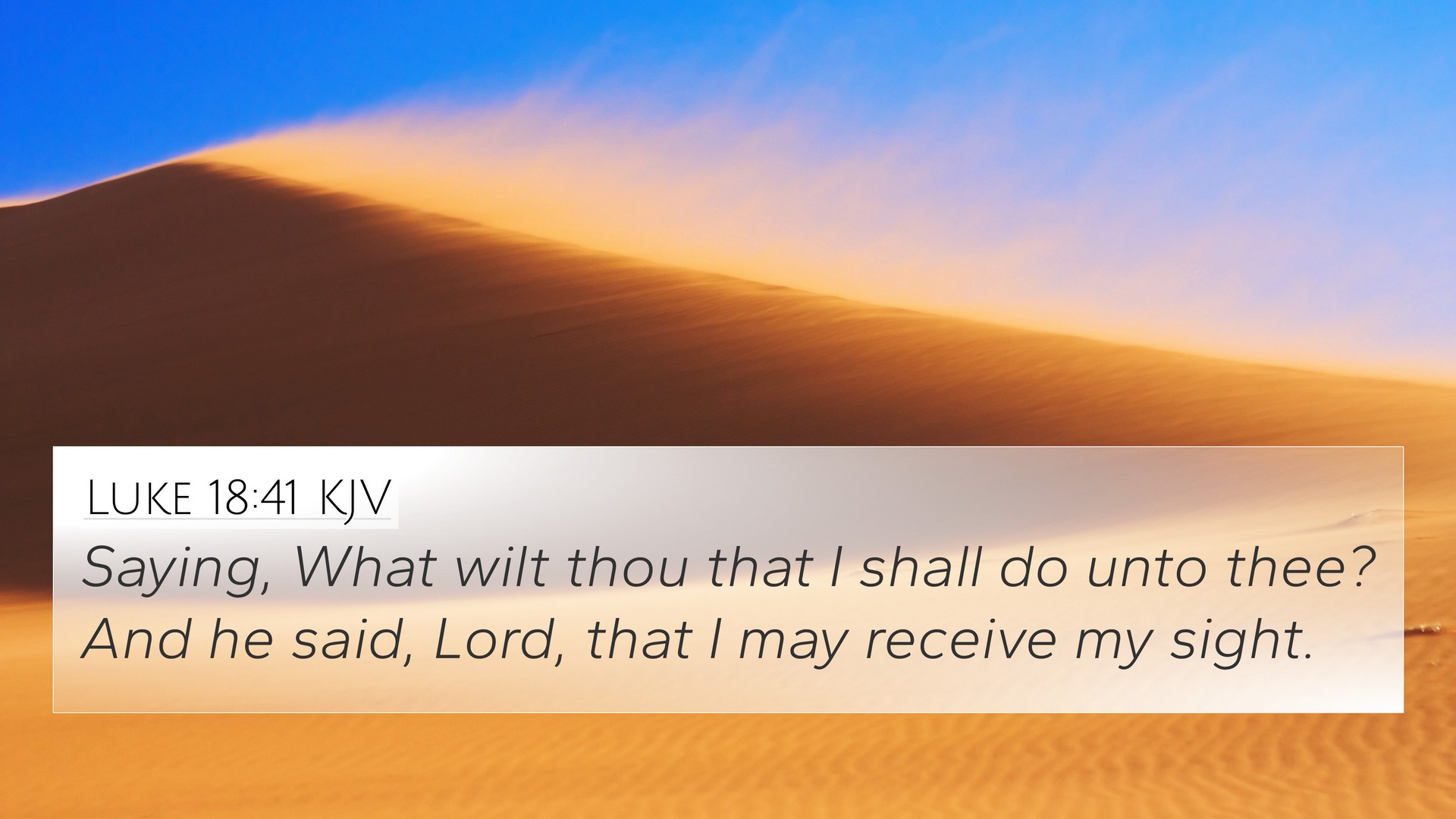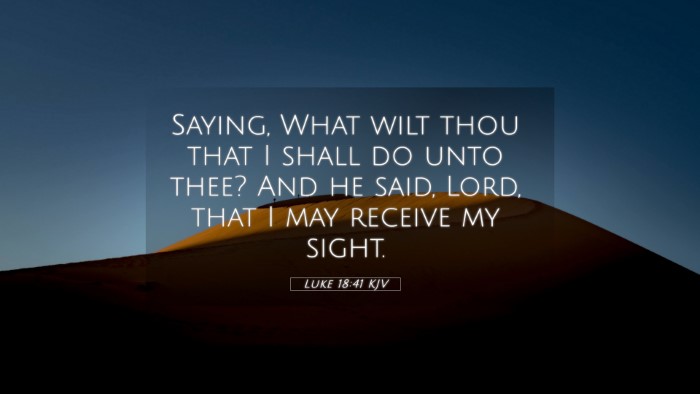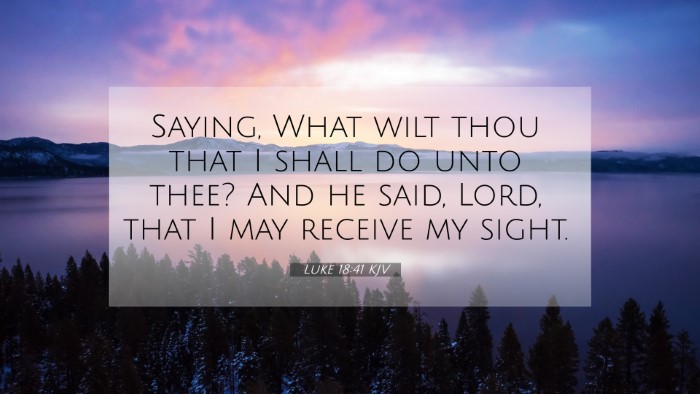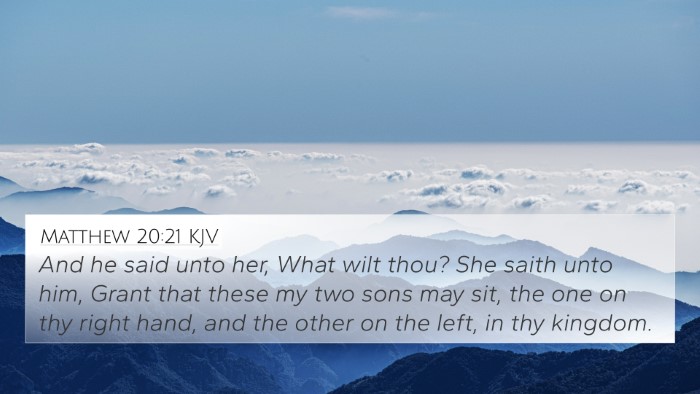Bible Verse Meaning: Luke 18:41
Luke 18:41 reads: "What do you want me to do for you?" He said, "Lord, I want to recover my sight."
Summary of Insights
This verse presents a powerful moment between Jesus and a blind man seeking healing. The dialogue highlights the personal nature of Jesus' ministry and His willingness to engage with the needs of individuals. Below is a synthesis of insights drawn from various public domain commentaries.
- Matthew Henry: Henry emphasizes the significance of the blind man's request, showing that it reflects the human desire for restoration and the importance of faith in seeking help from Christ. He notes that Jesus' question invites us to articulate our needs, demonstrating God's attention to our personal situations.
- Albert Barnes: Barnes points out that the blind man's response is a model of faith. He acknowledges Jesus as "Lord," suggesting an understanding of Jesus' divine authority. This act of calling on Jesus for mercy indicates a reliance on Christ's power to heal not only physical ailments but also spiritual blindness.
- Adam Clarke: Clarke adds depth by linking this event to the concept of spiritual sight, discussing how the blind man's physical blindness symbolizes the spiritual blindness present in many. The healing signifies the work of Christ in enlightening hearts and minds to the truth of the Gospel.
Connections Between Bible Verses
Luke 18:41 connects with various scriptures that explore themes of faith, healing, and divine compassion. Below are notable cross-references:
- Matthew 20:29-34 - This passage describes another instance of Jesus healing blind men, reinforcing the transformative power of faith and Jesus' mercy.
- John 9:1-7 - The story of the man born blind emphasizes Jesus' ability to give sight, both physically and spiritually, affirming the connection to Luke 18:41.
- Mark 10:46-52 - The healing of Bartimaeus closely parallels Luke 18:41, illustrating consistency in the narratives and the importance of faith in receiving healing.
- Psalm 146:8 - This Old Testament verse speaks to God's restorative capabilities, serving as a thematic link to the healing depicted in the New Testament.
- Isaiah 35:5-6 - Prophetic insights regarding the coming of the Messiah include healing and restoration, framing Jesus' actions in the context of fulfillment of prophecy.
- James 5:14 - The call to seek prayer for those who are in need of healing aligns with the themes present in Luke's account of Jesus' ministry.
- Luke 4:18-19 - Jesus’ mission statement highlights His purpose in healing the brokenhearted, echoing the needs expressed by those like the blind man in Luke 18:41.
- Romans 10:12-13 - Here, Paul discusses calling upon the name of the Lord for salvation, which parallels the blind man's act of faith in Jesus.
- John 8:32 - Discovering the truth leads to freedom—a spiritual healing that complements the physical healing sought in Luke 18:41.
- 2 Corinthians 4:4 - This passage delves into the theme of blindness and the need for light, relevant to understanding Luke 18:41's emphasis on sight and enlightenment.
Thematic Bible Verse Connections
Luke 18:41 embodies several biblical themes, advocating for faith as a mechanism for divine intervention. The interplay of physical and spiritual healing throughout scripture underscores the holistic nature of salvation presented in the Gospel.
Tools for Bible Cross-Referencing
For those interested in deeper studies of cross-referencing and thematic connections, consider utilizing the following tools:
- Bible concordance
- Bible cross-reference guide
- Cross-reference Bible study materials
- Bible reference resources for sermon preparation
- Comprehensive Bible cross-reference materials
How to Use Bible Cross-References
Utilizing cross-references can enhance understanding and interpretation by:
- Identifying connections between Old and New Testament
- Engaging in comparative studies of Gospels
- Unpacking parallels in Biblical themes
- Interpreting teachings through an interconnected lens
Conclusion
Luke 18:41 serves as a vital scripture reflecting the dialogue between faith and healing, inviting readers to explore the intricacies of their own faith journeys and the power of Jesus to restore sight—both physically and spiritually. As believers, we are encouraged to approach Jesus with our needs, trust in His mercy, and explore the rich tapestry of scripture through cross-referencing.






